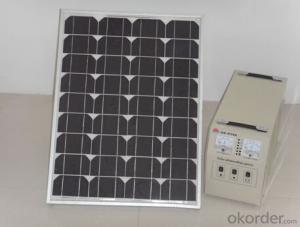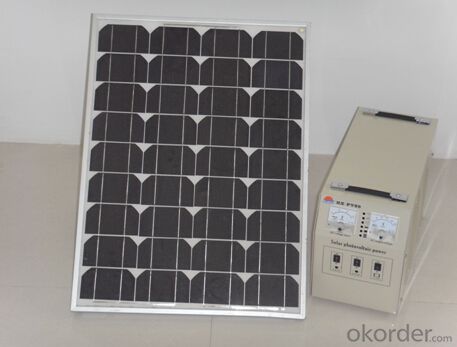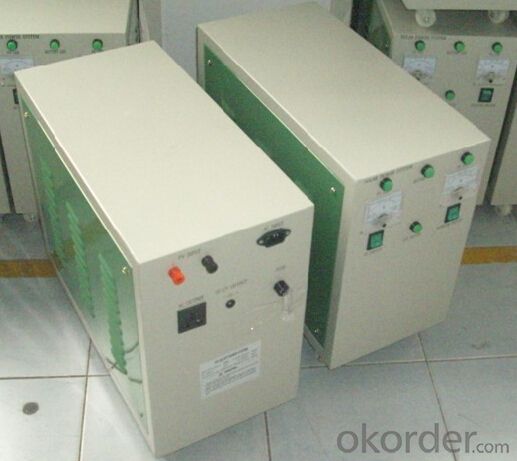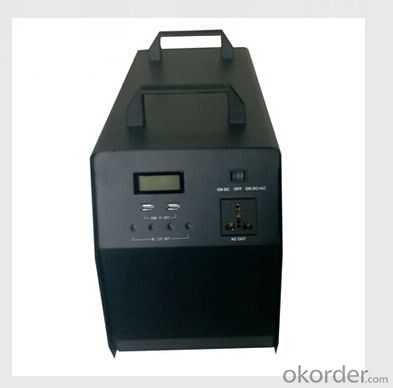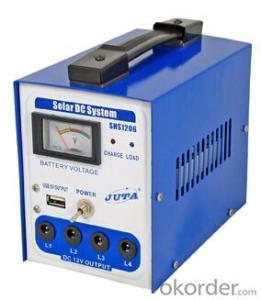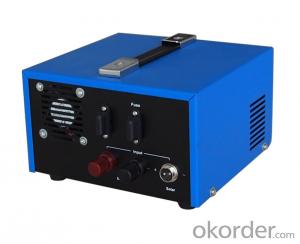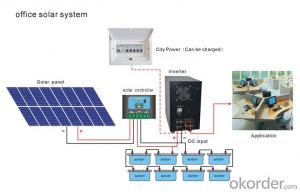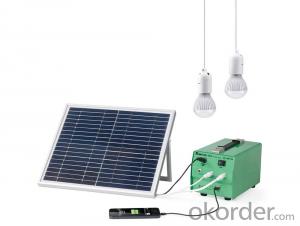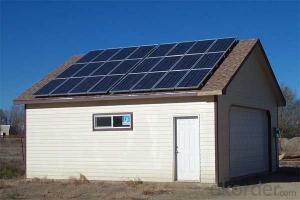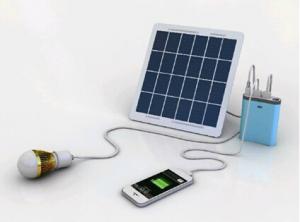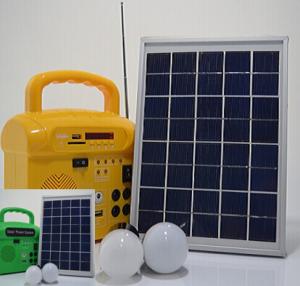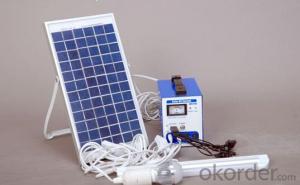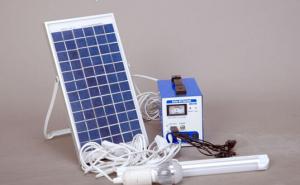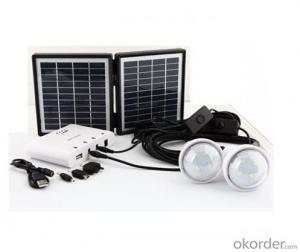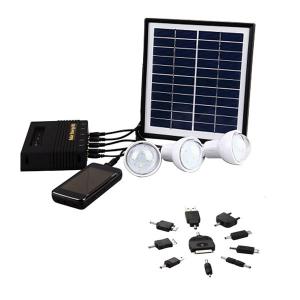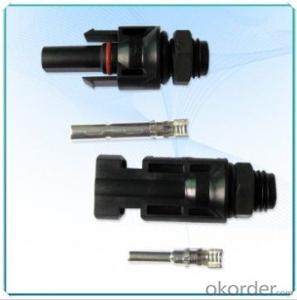Solar Energy Systems Adelaide - CNBM Solar Home System Roof System Capacity-80w
- Loading Port:
- Shanghai
- Payment Terms:
- TT or LC
- Min Order Qty:
- 10 PCS
- Supply Capability:
- 500000 PCS/month
OKorder Service Pledge
OKorder Financial Service
You Might Also Like
Introduction of Solar Home System
Solar Home System is composed by Solar Panels, Inverters, Charger Controller, Battery, Cable, Mounting Bracket, which is applied to produce electricity for home use.
Solar Home System is quite suitable product in urban area and the place which is short of electricity. As the cost of solar products reduced, more and more family can bear the charge of solar products. These products apply to schools, hospitals, public halls and private housing, communication stations, weather station. Also can use as household appliances, lighting, communications equipment, meteorological equipment.
Our company’s main target is to make every family can use cheap solar energy and enjoy the new innovation of modern science and technology.
Picture of Our Factory

Working Principle of Solar Home System
This is an off-grid solar system which uses batteries to store the solar energy, at the same time, the solar system can be connected with the grid for utilization of grid power. The solar system uses battery power in priority, but when sunshine is not so good or loads consumption is too big which caused the battery power inadequacy, then the system can switch automatically to grid power supply. Meanwhile, the system can charge the batteries with grid power until batteries are fully charged. Then the solar system will switch back to battery power supply.
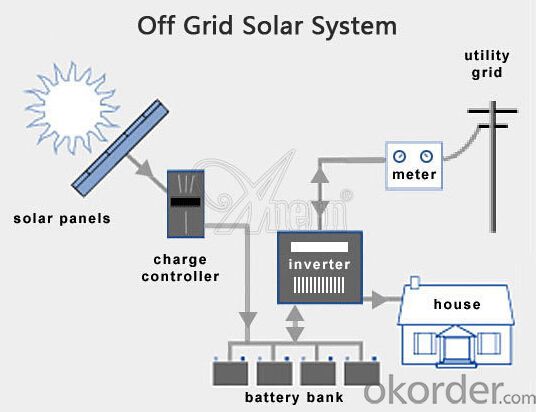
Product Details of Solar Home System
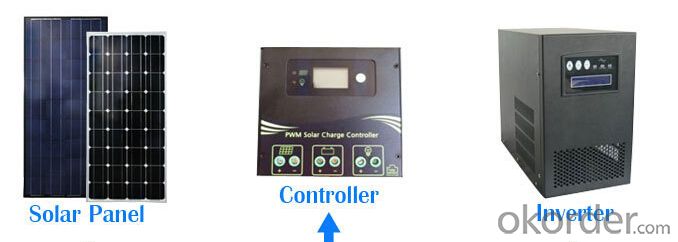
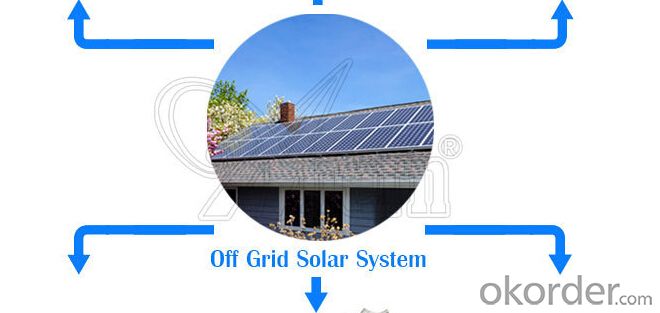

Specification of Solar Home System
Technical data: | |||||||||
Inverter | Rated load power | 500W | |||||||
Output wave | Pure sine wave | ||||||||
Input voltage | 24V | ||||||||
Output voltage | DC:12V | ||||||||
Output frequency | 50HZ/60HZ | ||||||||
Precision of output frequency | ±6% | ||||||||
Solar panel | Pmax | 100W*2PCS | |||||||
Vmp | 36V | ||||||||
Imp | 5.56A | ||||||||
Charger | Charger voltage & current | 24V10A | |||||||
Battery | Capacity | 12V80AH*2PCS | |||||||
Power box | Spray paint iron box,with input,output, ammeter,voltmeter,master switch and so on. | ||||||||
Package data: | |||||||||
Part | Size (L*W*H mm) | Weight (kg) | 20' (pcs) | 40' (pcs) | |||||
Power box | 580*520*540 | 60 | 96Sets | 240Sets | |||||
Solar panel | 1240*570*90 | 20 | |||||||
Solar panel bracket |
|
| |||||||
Loading electrical equipment(For consulting) | |||||||||
Name of Load | Power(W) | Quantity | Working Time per Day (H) | Working Days | |||||
Color TV | 65W | 1 | 4 | 3 days | |||||
Satellite TV Receivers | 25W | 1 | 4 | 3 days | |||||
lamp | 11W | 2 | 8 | 3 days | |||||
Other | 150W |
| 1 | 3 days | |||||
Advantage of Our Solar Home System
1 Excellent Performance: Our Solar Home System is composed by Brand Standard Kits with high quality. Our solar system has the advantage of high efficiency and stable operation. We can ensure our product with a long life period.
2. Small Orders Accepted: We can accept small orders as our customer’s trial order.
3. Guarantee/Warranty: We supply 10 Years Product Warranty and 25 Years Performance warranty.
4. Warehouse: We have warehouse overseas which can bring great convenience to our customer to pick up the products.
FAQ
Q: You are a manufacturer or Trader?
A: We are a Group corp. with 1GW capacity, which is Okorder’s registered VIP Supplier, enjoy Okorder’s Financial Guarantee.
Q: Required mainly certificates (CE&IEC/TUV/RoHS)?
A: Our products are certificated by CE RoHS, IEC, C-tick etc.
Q: Your main exported market is?
A: Main markets of our products is: South-east Asia, Mid-east, Arica, East Europe and Latin America.
- Q: Can solar energy systems be used in areas with high levels of seismic activity?
- Yes, solar energy systems can be used in areas with high levels of seismic activity. However, it is important to design and install these systems with proper engineering considerations and precautions to withstand potential earthquakes. By implementing robust mounting structures, flexible connections, and secure anchoring systems, solar panels can be made resilient to seismic forces. Additionally, regular inspections and maintenance should be carried out to ensure the integrity and safety of the solar energy systems in earthquake-prone areas.
- Q: Can solar energy systems be used in conjunction with other energy sources?
- Yes, solar energy systems can be used in conjunction with other energy sources. This is known as a hybrid energy system, where solar power is integrated with other sources such as wind, hydro, or traditional grid electricity. These hybrid systems help ensure a stable and reliable energy supply, especially during periods of low sunlight or high energy demands. By combining multiple energy sources, the overall efficiency and resilience of the system can be increased, contributing to a more sustainable and diverse energy mix.
- Q: How do solar energy systems affect the carbon footprint?
- Solar energy systems have a significant positive impact on reducing carbon footprint. By harnessing the sun's energy to generate electricity, solar systems eliminate the need for fossil fuels, which are major contributors to carbon dioxide emissions. This clean and renewable source of energy not only helps combat climate change but also reduces air pollution and dependency on non-renewable resources.
- Q: Can solar energy systems be used for powering wastewater or sewage treatment plants?
- Yes, solar energy systems can be used for powering wastewater or sewage treatment plants. Solar energy can be harnessed through the use of solar panels or solar thermal systems to generate electricity or heat, which can then be used to power various processes in these treatment plants. Solar panels convert sunlight into electricity using photovoltaic cells, which can be installed on the rooftops or open fields near the treatment plants. This electricity can be used to power pumps, blowers, and other equipment required for the treatment process. By using solar energy, these plants can significantly reduce their reliance on traditional grid electricity, leading to cost savings and a reduced carbon footprint. Solar thermal systems, on the other hand, use the sun's heat to generate hot water or steam. This heat can be utilized in the treatment process, such as for heating up water or sludge, which is essential for effective treatment. Solar thermal systems can be integrated into the existing infrastructure of the treatment plants, providing a sustainable and renewable source of thermal energy. In addition to reducing operational costs and environmental impact, solar energy systems also offer the advantage of being decentralized and independent from the grid. This means that even in remote areas or during power outages, the wastewater or sewage treatment plants can continue to operate efficiently. Overall, the use of solar energy systems for powering wastewater or sewage treatment plants is a viable and sustainable solution that can contribute to a cleaner and more energy-efficient water management system.
- Q: What are the disadvantages of using solar energy systems?
- Solar energy systems offer numerous benefits, but it is important to consider the drawbacks as well. There are several disadvantages associated with using solar energy systems, including the following: 1. High initial costs: The installation and setup of solar panels and necessary equipment can be expensive. This can be a significant investment for homeowners or businesses, making it less viable for those with limited financial resources. 2. Dependence on sunlight: Solar energy systems rely on sunlight to generate electricity. As a result, energy production can be intermittent, as they do not generate electricity during cloudy days or at night. To overcome this limitation, energy storage systems or backup power sources are needed, which can increase costs. 3. Space requirements: Large-scale solar energy systems require a significant amount of space for installation. This can be a challenge in densely populated areas or places with limited land availability. Additionally, rooftop installation may not be possible for buildings with structural limitations or in shaded areas. 4. Environmental impact of manufacturing: While solar energy systems produce clean and renewable energy, the manufacturing process can have environmental consequences. The production of solar panels involves the use of potentially hazardous materials and requires a significant amount of energy. The disposal of these panels at the end of their lifespan also presents environmental challenges. 5. Performance variability: The efficiency of solar panels can vary depending on factors such as location, weather conditions, and maintenance. Dust, debris, or shading can reduce their efficiency, necessitating regular cleaning and maintenance. 6. Limited energy storage capacity: Storing excess energy generated by solar panels is vital for consistent power supply during periods of low sunlight. However, current energy storage technologies, such as batteries, have limited capacity and can be expensive, restricting the ability to store large amounts of energy for later use. 7. Geographic limitations: Not all regions receive the same amount of sunlight, which affects the efficiency and effectiveness of solar energy systems. Areas with low solar radiation or extreme weather conditions may not be suitable for efficient harnessing of solar energy. Despite these disadvantages, ongoing technological advancements and research aim to address these challenges and make solar energy systems more accessible, efficient, and cost-effective.
- Q: Are there any fire safety concerns associated with solar energy systems?
- Yes, there are fire safety concerns associated with solar energy systems. While solar energy systems are generally considered safe and reliable, there have been instances where these systems have caused fires. One potential fire safety concern is related to faulty installation or maintenance of the solar panels. If the panels are not properly installed, there is a risk of electrical faults or short circuits, which can lead to overheating and potentially cause a fire. Similarly, if the system is not regularly inspected and maintained, it can increase the risk of electrical failures and subsequent fires. Another concern is related to the electrical wiring and connections of the solar energy system. Faulty wiring or loose connections can generate heat and may result in electrical fires. This is particularly relevant in older systems where wiring may have deteriorated over time. Moreover, during a fire incident, firefighters may face additional challenges when dealing with buildings equipped with solar energy systems. The presence of live electricity generated by the panels can pose a risk to firefighters, making it more difficult to safely extinguish the fire. To mitigate these fire safety concerns, it is crucial to ensure that solar energy systems are installed by qualified professionals following the necessary codes and regulations. Regular inspections and maintenance should also be conducted to identify and address any potential issues promptly. Additionally, it is important for firefighters to receive proper training on how to handle fires involving solar energy systems to minimize risks.
- Q: What is the difference between a solar thermal system and a photovoltaic system?
- Solar energy systems come in different forms, such as solar thermal and photovoltaic systems, each serving distinct purposes. When it comes to heating, a solar thermal system takes the lead. It operates by harnessing the sun's energy and directly heating water or air. This is achieved through the use of solar collectors, which absorb sunlight and convert it into heat. The heated water or air can then be utilized for space heating, water heating, or even powering turbines to generate electricity. These systems are commonly utilized in residential, commercial, and industrial settings to provide efficient heating solutions. On the other hand, photovoltaic systems, often referred to as solar panels, are primarily designed to generate electricity. They make use of photovoltaic cells, typically composed of silicon, to directly convert sunlight into electrical energy through the photovoltaic effect. These cells are interconnected within solar panels, and multiple panels can be combined to create a complete photovoltaic system. The electricity produced by a photovoltaic system can be utilized to power electrical devices, appliances, or even be fed into the grid to offset energy consumption. To summarize, the key distinction between a solar thermal system and a photovoltaic system lies in their respective functions. While solar thermal systems focus on heating applications by directly utilizing the sun's energy to heat water or air, photovoltaic systems are specifically designed to generate electricity through the conversion of sunlight into electrical energy using solar panels.
- Q: Can solar energy systems be used in countries with low sunlight availability?
- Solar energy systems can still be employed in countries with limited sunlight. Although these systems depend on sunlight to produce electricity, technological advancements now enable the efficient capture and utilization of even small amounts of sunlight. Moreover, solar energy systems can be engineered to integrate other renewable energy sources like wind or hydroelectric power to compensate for the scarcity of sunlight. Furthermore, energy storage systems like batteries can store surplus energy during periods of low sunlight and release it as required. Consequently, solar energy systems remain a feasible and sustainable choice for electricity generation even in countries with insufficient sunlight.
- Q: What are the different financing options for solar energy systems?
- There are several financing options available for solar energy systems, including cash purchases, solar loans, solar leases, power purchase agreements (PPAs), and property assessed clean energy (PACE) financing. Cash purchases involve paying the full cost of the system upfront. Solar loans allow homeowners to borrow money to finance the system and pay it back over time with interest. Solar leases involve leasing the system from a third-party provider and paying a fixed monthly fee. PPAs allow homeowners to purchase the electricity generated by the system at a predetermined rate. PACE financing allows homeowners to finance the system through an additional assessment on their property taxes.
- Q: Can solar energy systems be installed on all types of roofs?
- Yes, solar energy systems can be installed on all types of roofs, including flat roofs, sloped roofs, metal roofs, tile roofs, and shingle roofs. However, the design and installation process may vary depending on the specific roof type.
Send your message to us
Solar Energy Systems Adelaide - CNBM Solar Home System Roof System Capacity-80w
- Loading Port:
- Shanghai
- Payment Terms:
- TT or LC
- Min Order Qty:
- 10 PCS
- Supply Capability:
- 500000 PCS/month
OKorder Service Pledge
OKorder Financial Service
Similar products
Hot products
Hot Searches
Related keywords
